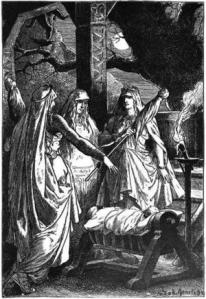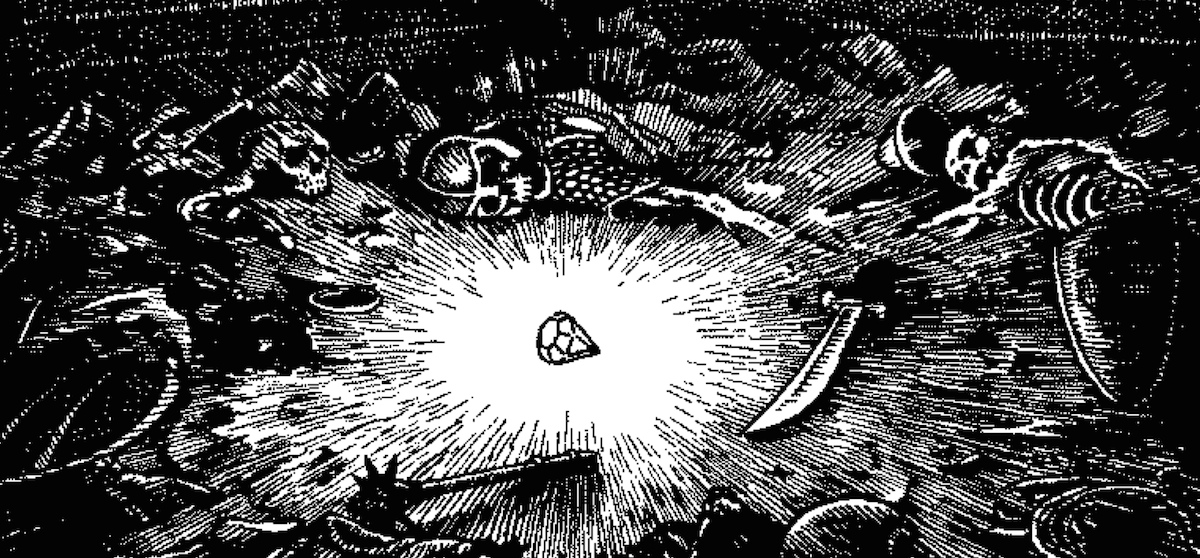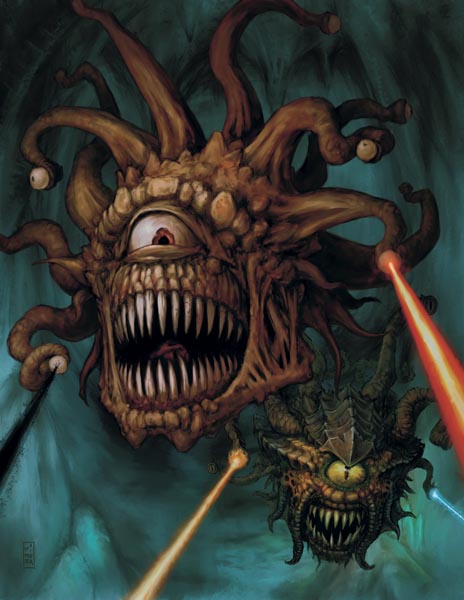The venerable Dungeons & Dragons franchise, the granddaddy of the modern role-playing game, is now in its 5th edition. And, to hear publisher Wizards of the Coast tell it, the sourcebooks are selling like hot cakes. More people than ever before are discovering the magic of rolling dice and telling stories with their friends, and lapsed fans are returning in droves.
For lead designer Mike Mearls, that’s created a bit of a problem. How do you keep the source material fresh for a 42-year old franchise? And, when you’re in the business of selling books, how do you make the next one more interesting than the last?
Consider a pillar of the franchise, the sourcebook known as the Monster Manual. The first, titled simply Monster Manual, was published in 1977. Since then there have been 18 iterations, some for different editions of the game with different rulesets, others with slightly different snippets of lore. But, through the decades, it’s always been roughly the same thing: An alphabetical list of monsters.
“I have this kind of personal philosophy for managing the product line,” Mearls said last month in Renton, Washington. “I don’t want to duplicate any product that’s come before. I think that if people have seen it, then it’s not really new and it’s not really exciting.”
/cdn0.vox-cdn.com/uploads/chorus_asset/file/7302181/monstermanual.0.jpg)
This time around, he and his team have decided to do something a little bit different. Their next take on the Monster Manual will be called Volo’s Guide to Monsters and, for the first time, it will have a lot more character to it.
“It’s risky,” Mearls said. “In the end, it’s still a giant book full of monsters. No one would argue with that. But I just think that if that’s all the Monster Manual is, then we’re selling ourselves short. So the idea was, the kind of genesis of it, was that want to do something that’s more story oriented.”
Volo’s Guide will have a narrator — two actually. One will be Volothamp Geddarm, an over-the-top, braggadocious explorer. The other will be Elminster, the wise Sage of Shadowdale. And the two will often be at odds with one another. Their differing accounts will be scattered throughout the book, and take the shape of comments scribbled in the margin.
WIZARDS OF THE COAST WANTS THEIR SOURCEBOOKS TO BE FUN TO READ.
Put simply, the goal is to create a book that high-level players and dungeon masters will enjoy reading. The goal, in the end, is to inspire new stories at the table, not simply reinforce the lore of the Forgotten Realms and ram storylines down player’s throats.
“I have this pet phrase I use,” Mearls said. “I like to say that we’re living in a post Game of Thrones world. Fantasy has changed.
“If you look at science fiction follows, I think an arc that fantasy is following now. In the 50’s, science fiction was very iconic, and at least in movies, very much templated. You had the flying saucer, or the rocket ship, you had either the aliens who were clearly monsters — like the guy in the deep sea diving helmet wearing the gorilla coming to eat people or whatever. Or they were people in funny outfits who were very inscrutable and so much more advanced that we were, and that was your pantheon.”
Later, as science fiction entered the ‘60s and the ‘70s, it began to be entrusted with more serious themes and dealt with issues of change in modern culture as a whole.
“So you have this new wave of science fiction coming through and science fiction grows up,” Mearls said. “It became Alien — a horror movie in outer space. It becomes Soylent Green, which is kind of like this social commentary on science fiction. It’s Rollerball, right? This entire thing about what’s it really mean to have free will, and can there really be freedom in a technological society? But it’s still science fiction.”
THE FANTASY GENRE IS GROWING UP.
Mearls sees Game of Thrones as evidence of the same kind of evolution in the fantasy genre, and it’s his hope that Volo’s Guide can become a new kind of sourcebook to help bring about new kinds of stories.
So what’s inside? I’ve had an advanced digital copy for a few weeks now and I’m pretty impressed at what I’ve found.
The first third of the book is a series of deep dives on specific species of monsters. How specific? Mearls and his team lavish nearly 14 full two-column pages on beholders alone, exploring every aspect of their nature both in and out of combat.
Most of the information is great fodder for dungeon masters. How do you roleplay a beholder? How do you speak like a giant? What does their four-tier caste system contribute to goblin society? What does a gnoll chant to keep his spirits up while on the hunt? What is the lifecycle of a mind flayer?
Well, actually, I’ll let Volo himself handle that last one.
/cdn0.vox-cdn.com/uploads/chorus_asset/file/7301811/Screenshot%202016-10-18%2015.19.20.png)
Ever wondered what a hag is most likely to drive off the used car lot, or fancied a careful examination of the kobold pantheon? It’s all in there, and something is going to light a fire in your mind and bring a richer, more memorable experience to the table.
The second third of the book might be my favorite. I’m not able to share much, but suffice it to say that with Volo’s Guide both dungeon masters and players will be able to bring new races to the table, both as player and non-player characters. That includes rules for goblins, orcs and even something called a “firbolg.”
The final third contains rules for 96 monsters that are new to fifth edition, including the Gauth and the Mindwitness.
/cdn0.vox-cdn.com/uploads/chorus_asset/file/7301825/Screenshot%202016-10-18%2015.24.28.png)
/cdn0.vox-cdn.com/uploads/chorus_asset/file/7301833/Screenshot%202016-10-18%2015.26.14.png)
All told, Wizards of the Coast sent over six pages to share with our readers. We’ll include the final three below.
The very last section of the book features a great add-on. It’s a nice little appendix that includes a handful of fully detailed stock NPCs. It makes the entire package a fantastic resource for dungeon masters, turning a pretty standard sourcebook into a self-contained toolkit capable of spawning dozens of different dungeons — or sparking entire campaigns — without very much prep work at all.
To create it, Mearls says his team has had to take a long hard look at Dungeons & Dragons’ oldest and most iconic creatures. Their goal was to explain them to a degree that’s never been canonically attempted before in one place.
“If you take a look at something like a mind flayer,” Mearls said, “it has that sort of ‘50s science fiction feel. It’s the creepy monster that lives under the bed and eats your brain by the end of story. But I think with a 21st century approach, you can say, ‘Well, who is the mind flayer.’ And it sounds funny, but then you start getting into it. What’s with this guy eating brains?
“Dungeons & Dragons was very much developed with this almost scientific mindset,” Mearls said. “What’s the biology of the mind flayer? But no one asked about its feelings. But when you think about, it the game tells me that mind flayer has an 18 intelligence. The highest intelligence a human can achieve, that’s their average. Literally, they walk in the room and they are the smartest being there. They are smarter than every human they’ve ever ate. So talking to us is like meeting dogs, for them. What’s that got to be like?”
Mearls says that, if the book is successful, he intends for his team to handle more of their upcoming sourcebooks in a similar way.
Volo’s Guide to Monsters will be available at your friendly local game store on Nov. 15. You can also find it on Amazon. It’s also the first Dungeons & Dragons product to have a collectible, alternate cover which you can see here  .
.
/cdn0.vox-cdn.com/uploads/chorus_asset/file/7301905/Screenshot%202016-10-18%2015.37.23.png)
/cdn0.vox-cdn.com/uploads/chorus_asset/file/7301913/Screenshot%202016-10-18%2015.37.45.png)
/cdn0.vox-cdn.com/uploads/chorus_asset/file/7301915/Screenshot%202016-10-18%2015.38.01.png)



 If you are ready to design your first RPG adventure, or learn how to improve the adventures you’ve already got, you’ve come to the right place. The “Adventure Builder” will cover all the bases, from hooks to background to traps and treasures.
If you are ready to design your first RPG adventure, or learn how to improve the adventures you’ve already got, you’ve come to the right place. The “Adventure Builder” will cover all the bases, from hooks to background to traps and treasures. 1) Two Skill Encounters: These are creatures or obstacles that can be defeated by stealth or skill, such as guards, castle walls, cliffs, informants, or low-hp creatures that can fall to a single sneak attack.
1) Two Skill Encounters: These are creatures or obstacles that can be defeated by stealth or skill, such as guards, castle walls, cliffs, informants, or low-hp creatures that can fall to a single sneak attack.


























ESSAYS ON GAME DESIGN: To Hell With Balance
Sep 9
Posted by occu77
ESSAYS ON GAME DESIGN
Essay Two: To Hell With Balance
I’m gonna say something that might shock some of you guys. Then again, maybe not.
Balance, go to the Devil, and burn in hell. And while there sip septic tea with him til you’re really needed again. And chances are it won’t be often. But whatever the case, don’t call me, I’ll call you.
I’m working on a fantasy Role Playing Game, I’m not designing an algorithm, doing covalence equations, or writing a computer program to calculate a moonshot at apogee.
So sometimes in-game my players get their noses busted and spleens ruptured by a dragon that in real life they couldn’t ever easily kill. Not with bow-sticks and knives and harsh words anyways. Good, it’ll teach em a lesson about danger and risk and what it actually costs people.
And sometimes they’ll whip out their Horn of Resounding and bring down the walls of Jericho, or slay a few giants with the Jawbone of an ass. Good, sometimes you catch a miracle in midair, deserved or undeserved. Sometimes you get the bear, and sometimes he gets you. That’s life.
But in any case, as far as the game goes, the player is fascinated, interested, intrigued, involved, worried, anxious, and maybe even occasionally excited again. Perhaps shocked and ecstatic from time to time too, just to boot.
Balance, he ain’t my god. I don’t owe him any real sacrifices. He’s more like the grey-skinned Graeæ sisters than bright Apollo. Only one eye to see with, a lot of double talk, the bite of a one-toothed wonder – and in the end, disaster, not glory. You can’t trust Balance to point the way to the future, cause he’s more consumed with his own reflection in the mirror than with anything remotely heroic happening. Static, stale, sterile, sluggish, and simple-minded. A dotard of dullness. No poetry of soul, just an arrested arithmetic of tedium. More Echo and Narcissus, more Sound and Fury, than Thunder and Lightning.
I liked the original version of D&D. I like the 4th Edition, at least many things about it. But I see now that this pernicious idea of “balance” that crept in like the Serpent at Eve in Paradise, balance as an end in itself, especially in a fantasy game of all things, is more assassins’ poison than golden Ambrosia. If I have to kill wonder and potential just to achieve balance, then I have to kill fantasy just to achieve boredom. Thank you modern RPG Fantasy Game Theory of Balance, but I think you’d be happier working as a stock-boy in the warehouse of modern mediocrity, than a gate-keeper to the temples at Mount Olympus.
So Balance, my fine feathered fowl of gutless acquittal, go to hell and burn awhile. Maybe you’ll cook into a decent potpie.
Invention is as invention does. So, I’m gonna start designing fantasy games and adventures again, even D&D ones, where magic happens, miracles save the day, monsters are dangerous and feral, the voice of God rumbles across the sky, kingdoms topple, heroes struggle, players say, “Now that’s what I’m talking ‘bout!” and imaginations catch fire.
Balance can burn in his own oven… and stew in his own juices.
Share this:
Posted in Adventure/Adventure Development, Commentary, DESIGN OF THINGS TO COME, Dungeon Master/Game Master, Essay, Game Design, Gaming, MY WRITINGS AND WORK, Uncategorized
2 Comments
Tags: role playing